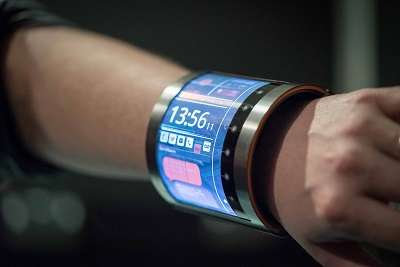February 24, 2016 weblog
FlexEnable shows vision in wrist-hugging display at MWC

Please. Could you ever really expect to walk away from Mobile World Congress without hearing vendor words such as "bendy" "curve" and "flex"?
FlexEnable, based in Cambridge, UK, gave signs that the display screen technology is on a roll (no pun intended) when it showcased an organic liquid crystal display (OLCD) wrist device for wearable applications at the Barcelona event.
Curved into a smartwatch form factor, this is a 0.3mm-thick display component. The 0.3mm-thick organic OLCD screen was incorporated into the prototype smartwatch.
The company was not at the event to preview sales of wrist wearables but to make a point—-flexible display technology brings much to the future of wearables. The use of flexible displays means that wearable products avoid constraints by rigid design dimensions, but instead can conform to the wearer and not the other way around.
"Being extremely light and thin, flexible displays save space that can be used to improve product form factors and include additional components or battery capacity." In addition to just a standard smartwatch interface, the OLCD can run vivid color and smooth video content.
The Verge's James Vincent, making the rounds at the Mobile World Congress on Monday, stopped to look at the screen being showcased. Vincent pointed out that the company does not make any consumer products itself; the wrist device was a demo based on something called plastic transistor technology.
This means you can curve it around your wrist—but hold on the word curve. "You can't fold it and open it up like maybe some of the prototype smartphones you have seen from Samsung, he said in The Verve video." Vincent said in the article itself, that "although OLCD can flex a little, it's not the sort of material you can endlessly bend and crease" –which, said the company's Cain, "will have to wait for flexible OLED displays, a technology that is going to need more development."
The company's technology gives plastic LCDs the same optical performance as glass LCDs, said FlexEnable, while removing the constraints of glass.
"We developed, alongside our partner Merck, the world's first OLCD – glass-free, bendable, light and thinner than conventional LCDs, and lower cost than other flexible display technologies." Last year, a joint project was announced where Merck was partnering with FlexEnable. According to the announcement, the two companies reached "an important next stage in plastic LCD technology."
A plastic LCD, they said, was completely free of glass, instead using organic transistors on a plastic sheet. "Ultimately," said the announcement, "it shows a route to low-cost solutions for volume manufacturing with LCDs."
How long until we see fully-fledged wristbands like this on the market? Eighteen months is the optimistic guess from FlexEnable's Paul Cain, said The Verge. "The firm says its technology is ready to go, and it's apparently in talks with unnamed hardware partners who want to make this sort of device a reality."
More information: www.flexenable.com/newsroom/fl … e-applications-at-m/
© 2016 Tech Xplore





















